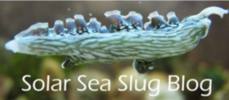Posts in Category: General Slug Things
Slugs of Bonaire
I know you have all been eagerly awaiting the most recent slug photos from our trip to Bonaire. We had hoped to find some of the less common species, such as E. ornata, E. subornata or E. picta, but efforts to find a local expert to help locate suitable habitats were not successful this time around. Apparently, not everyone is as fascinated by this marvelous genus of slugs as I am. I gave up rather quickly trying to explain that, yes, I know that lettuce slugs (E. crispata) are common on the western side of the island, and no, I am not looking for colorful nudibranchs. Easier to nod my head enthusiastically.
Nonetheless, there were plenty of E. crispata to be had, which was just marvelous. Here are a few of the little beauties we found. One characteristic of the species in the variability in color, and this group shows a little of the spectrum. The strobe failed early in the trip, but the slugs’ preference for shallow water provided the opportunity for available-light photography.
Below is a pastel green specimen, found at Margate Bay.
These two blue and green fellows were found huddled below a large gorgonian, next to a nice piece of fire coral. In the shallows of Red Beryl, one of our favorite sites at the south end of the island.
Below is “Tridachiasaurus,” the biggest slug I had ever seen. Hard to get a sense of scale in the photo, but notice the relative size of her rhinophores (normal sized rhinophores, dwarfed by a large body) and intense ruffling of her parapodia. Photographed at Andrea I, a nice dive site with relatively easy entry and exit.
Also at Andrea I, another blue and green specimen, showing the characteristic large, white spots on the midsection.
Here are a few other shots from among the hundreds. They may not be slugs, but it is my site, so I can post what I like.











Recent Comments